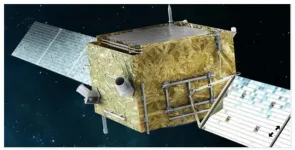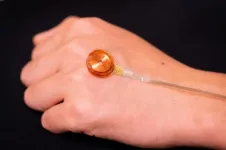Mechanically imprinting atoms in ceramic
'Science' publication by researchers under the leadership of the TU Darmstadt
2021-05-28
(Press-News.org) The findings have been published in "Science", the renowned journal.
The world market for electroceramics is in the region of 25 billion euros a year. These very small components are often not even perceived in daily life. A smartphone alone contains 600 capacitors, 3 trillion - that's 3000 billion - of which are manufactured every year. The way many electroceramics function is not based on current flow through the material, but on small charge dislocations, called polarisation, over fractions of an atomic diameter. About a quarter of the electroceramics produced in the world link this polarisation to an extension of the material, which in turn can be adjusted to the accuracy of an atomic diameter. Only then can ever-smaller computer components and microrobots be structured.
Replacing atomic series in the atom
The properties of the electroceramics can be improved by using chemical interventions to replace individual atoms in the regularly shaped crystal lattice with others (endowing) - a little like sitting a single Borussia Dortmund fan in a black-and-yellow jersey in a cinema full of FC Bayern Munich fans in red tops. However, where there are special requirements, such as a higher temperature or electric voltage, the endowed atom would lose its place (the fan would be pushed around), much to the detriment of the function of the ceramic.
The installation of individual atoms in a ceramic crystal lattice is not stable enough for complex requirements, but the installation of entire atomic series (displacement) is robust. In the football example, this would correspond to having a row of Borussia fans in among the Bayern fans. Material scientists from three working groups of the TU Darmstadt are cooperating with research groups from Switzerland, the Netherlands and the USA in the research on these displacements.
New atoms, new properties
"Chemical methods are no longer sufficient for planned displacements," explains Professor Jürgen Rödel, Head of the research group of Non-Metallic Inorganic Materials at the TU Darmstadt. Instead, the researchers succeeded in achieving the displacement mechanically. They used a process in which the ceramics are mechanically deformed under controlled pressure and temperature conditions so the displacement can be imprinted in the ceramic. An approach such as this is trivial with metals, but until now it was largely deemed impossible with ceramics because of their tremendous hardness. Plus the surface of ceramic is extremely brittle and can easily break. In order to overcome these obstacles, the scientists carried out a mechanical imprint at 1150 degrees Celsius in a single crystal of the previously calculated optimised orientation.
This method now allows a well-ordered field of newly occupied atomic rows. These series control the local polarisation, the load dislocation, in the material. As the imprinted series clearly limit polarisation, it cannot lose structure even under very high operating conditions. In the operation of electroceramics, the material areas now delimited by the series (displacements) take up certain charge shifts; continuing with the football analogy, it is as if the Bayern fans were to lean forward or to the side in sections. As these material areas do not change under high conditions, no energy is converted by internal friction and the material behaviour remains stable.
These materials now make it possible to ensure consistent properties even at raised temperatures and with increased energy use. At the same time, the researchers are addressing the cost reduction necessary in order to provide the displacements by means of several options of mechanical imprinting.
INFORMATION:
Reinhart Koselleck project:
The DFG has endowed the "Research into displacements in ceramics" as a Reinhart Koselleck project with 1.25 million euros for five years. The programme aims at freedom for particularly innovative and - in the positive sense - risky research, and so honours highly renowned scientists. This is the first time Professor Jürgen Rödel has applied for this type of DFG support for TU Darmstadt. In the adjacent fields of charge transport and the increase in the reliability of ceramics (ductile ceramics), there have already been a number of high-ranking publications and the first patent applications for his project. The number of international research partners is currently increasing very rapidly, and also includes teams in England, China and Japan in particular.
M. Höfling, X. Zhou, E. Bruder, B. Liu, L. Zhou, P.B. Groscewicz, F. Zhuz, L. Riemer, B.-X. Xu, K. Durst, D. Damjanovic, X. Tan, J. Koruza and J. Rödel: „Control of polarization in bulk ferroelectrics by mechanical dislocation imprint". In: Science Vol. 372, Issue 6545, pp. 961-964.
DOI: 10.1126/science.abe3810
Contact
Professor Dr. Jürgen Rödel
Fachbereich Material- und Geowissenschaften
Fachgebiet Nichtmetallisch-Anorganische Werkstoffe
Tel.: 06151/16-21693
E-Mail: Roedel@ceramics.tu-darmstadt.de
ELSE PRESS RELEASES FROM THIS DATE:
2021-05-28
UNIVERSITY PARK, Pa. -- Developing new ultrathin metal electrodes has allowed researchers to create semitransparent perovskite solar cells that are highly efficient and can be coupled with traditional silicon cells to greatly boost the performance of both devices, said an international team of scientists. The research represents a step toward developing completely transparent solar cells.
"Transparent solar cells could someday find a place on windows in homes and office buildings, generating electricity from sunlight that would otherwise be wasted," said Kai Wang, assistant research professor ...
2021-05-28
As the cleanest renewable energy, hydrogen energy has attracted special attention in the research. Yet the commercialization of traditional proton exchange membrane fuel cells (PEMFCs), which consume hydrogen and produce electricity, is seriously restricted due to the chemical reaction of PEMFCs cathode largely relies on expensive platinum-based catalysts.
A solution is to change the acidic electrolyte of PEMFCs to alkaline. Such fuel cells are called anion exchange membrane fuel cells (AEMFCs), and they allow for the use of cheaper metal elements like Co, Ni or Mn to design electrocatalysts.
The research team led by Prof. GAO Minrui from University of Science and Technology ...
2021-05-28
During the era of commercial whaling, fin whales were hunted so intensively that only a small percentage of the population in the Southern Hemisphere survived, and even today, marine biologists know little about the life of the world's second-largest whale. That makes the findings of researchers from the Alfred Wegener Institute, Helmholtz Centre for Polar and Marine Research (AWI) and the Johann Heinrich von Thünen Institute for Sea Fisheries, which show that a large number of the baleen whales regularly frequent the krill-rich waters surrounding Elephant Island, all the more welcome. Evidence for this is provided by underwater sound ...
2021-05-28
An international archaeological study, led by researchers from the Culture and Socio-Ecological Dynamics (CaSEs) research group at Pompeu Fabra University, has advanced in the understanding and preservation of archaeological sites and in improving their analysis and surveying, thanks to the application of pXRF (portable X-ray fluorescence analysis) to anthropogenic sediments in Africa. It is a rapid, inexpensive, non-invasive procedure, which enables generating an additional archaeological record from the anthropogenic deposit by analysing chemical elements, combined with geostatistics.
It is a rapid, inexpensive, non-invasive procedure, ...
2021-05-28
The work was conducted under the auspices of the Russian Foundation for Basic Research and organizations-participants of the BRICS framework program in science, technology and innovation; the grant title is "Nanosized peptide-based biomaterials for photodynamic diagnostics of tumors".
Project lead, Chief Research Associate of KFU's Bionanotechnology Lab Rawil Fakhrullin commented on the results, "The development of materials for theranostics (simultaneous early diagnosis and therapy of diseases) is one of the most urgent tasks in modern chemistry and biomedicine. A feature of such materials is the combination of at least two functions: sensory and therapeutic. ...
2021-05-28
A research group led by Takashi Saito, of the Ehime University Graduate School of Medicine, developed a 2-photon excitation light-sheet fluorescence microscope which (1) lowers phototoxicity, (2) extends the field of view, and (3) heightens spatial resolution. This microscope, when used for the observation of medaka fish, made it possible to observe the whole body of the embryo (an extended field of view) at a cellular level resolution (high spatial resolution) without affecting the growth of the fish (low phototoxicity) over a three-day span of embryonic development. ...
2021-05-28
The research team of the Department of Organic Chemistry of Samara Polytech under the leadership of Doctor of Chemical Sciences, Head of the Department Yuri Klimochkin and Doctor of Chemical Sciences, Professor Alexander Reznikov in cooperation with the crystallographic research group of Lomonosov Moscow State University (supervisor - candidate of chemical sciences, senior researcher Victor Rybakov) completed a study to obtain non-racemic 4,5-dihydrofurans based on Michael addition and study their chemical properties. The announcement of a scientific article with the results of the latest research is posted on the cover of the authoritative journal Tetrahedron.
"Studying the method of obtaining ...
2021-05-28
CHAPEL HILL, NC - A new study published in Nature Communications demonstrates that a consortium of bacteria designed to complement missing or underrepresented functions in the imbalanced microbiome of inflammatory bowel disease (IBD) patients, prevented and treated chronic immune-mediated colitis in humanized mouse models. The study's senior author, Balfour Sartor, MD, Midget Distinguished Professor of Medicine, Microbiology and Immunology, Co-Director of the UNC Multidisciplinary IBD Center, said the results are encouraging for future use treating Crohn's disease and ulcerative colitis patients.
"The idea with this treatment is to restore the normal ...
2021-05-28
Dark Matter Particle Explorer (DAMPE) Collaboration directly observed a spectral softening of helium nuclei at about 34TeV for the first time. This work was based on measurements data of the helium spectrum with kinetic energies from 70 GeV to 80 TeV (17.5 GeV/n to 20 TeV/n for per nucleon) recorded by the DAMPE.
The relevant results were published in Physical Review Letters.
Galactic cosmic rays (GCRs) offers important ways to deeply understand the astrophysical particle origin and accelerators and the interstellar medium of the Galaxy. Helium nuclei, the second most abundant nuclear element of cosmic rays, is a distinguishing feature of space.
As for GCRs, the energy spectrum is supposed to follow a negative power law distribution when energies are below the "knee" (at ...
2021-05-28
By putting a piece of soft, strain-sensing sheet on the skin may be able to detect skin disorders non-invasively and in real-time very soon. A research team co-led by a scientist from City University of Hong Kong (CityU) has designed a simple electromechanical device that can be used for deep tissue pathology diagnosis, such as psoriasis, in an automated and non-invasive fashion. The findings will lay a foundation for future applications in the clinical evaluation of skin cancers and or dermatology diseases.
The research is co-led by Dr Yu Xinge, Assistant Professor from CityU's Department of Biomedical Engineering, and scientists from and Northwestern University in the US. Their findings have been published in the science journal Nature Biomedical Engineering, titled "Miniaturized ...
LAST 30 PRESS RELEASES:
[Press-News.org] Mechanically imprinting atoms in ceramic
'Science' publication by researchers under the leadership of the TU Darmstadt






